Mom Transfers Two Embryos After IVF, Then Discovers She Was Already Pregnant — and Welcomes Triplets (Exclusive)
Shelby and Chase Stewart were looking to give their daughter Bennett a younger sibling, but a series of twists led the couple to welcoming triplets instead
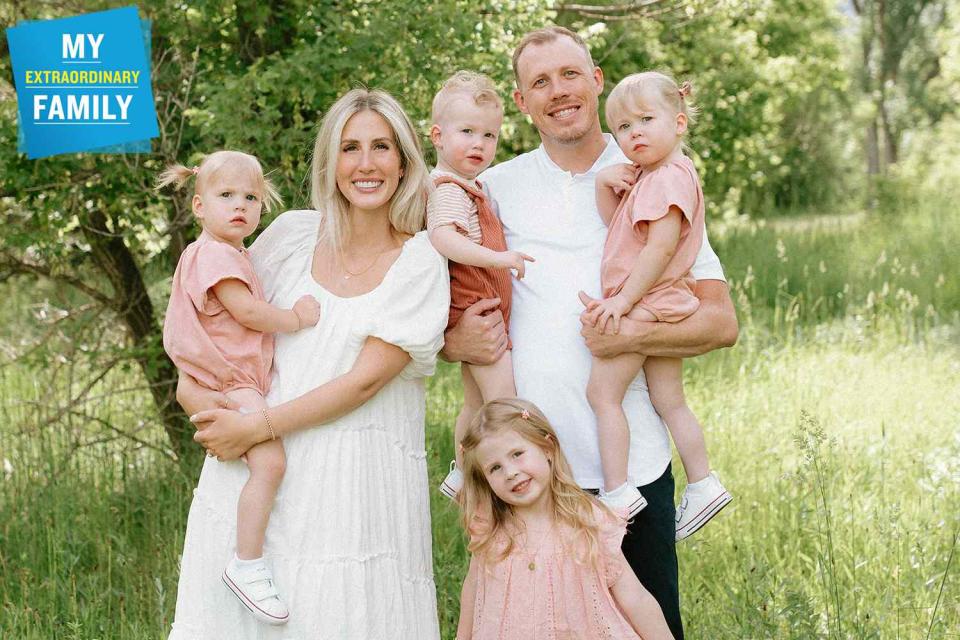
Emma Montgomery
Shelby Stewart and her husband Chase knew they wanted to grow their family, but never could have anticipated the twists their journey would take.
At the time, the couple were parents to daughter Bennett and wanted to have one more child, though their road to welcome their first baby hadn't been easy.
"I had cancer when I was 15 years old. I had non-Hodgkins lymphoma and so when I was 19, I was told I'd never have my own child," Shelby tells PEOPLE.
"They said I'd probably go into menopause by 26, and I was just floored by that because having kids really wasn't on my radar at that point in my life."
My Extraordinary Family is PEOPLE's new series that explores fascinating families in all their forms. If you have a sweet story the world needs to know, send the details to love@people.com.
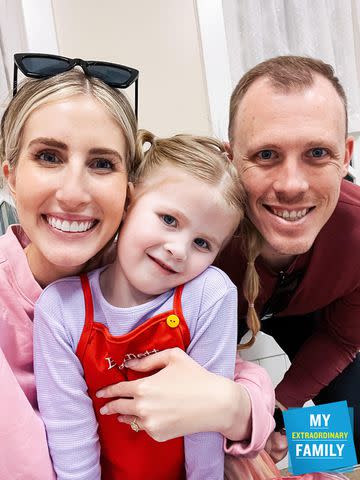
Courtesy Stewart Family
Shelby tried to look into egg retrieval but learned it wasn't an option and shelved the issue until she met Chase, 36, a few years later.
"We decided, 'We're just going to give it our best shot.' So I ended up going back to the fertility doctor after we were married and we'd been trying on our own for a year and a half."
The couple were eventually recommended in-vitro fertilization (IVF), but ended up trying intrauterine insemination (IUI) first, conceiving Bennett on the second try.
"I had her and when she was about six months, I was just turning 27. And so I thought, 'Okay, I have this miracle baby, but I'm supposed to be going into menopause. My small window is closing quickly and if we can have another baby, we should start trying.' "
The couple turned back to IUI, undergoing the process five times without success before turning their sights to IVF.
"I had three losses, five IUIs and three transfers, so we ended up having no more embryos left, which was really, really hard for us," Shelby recalls. "And at that point, we had sunk in a lot of money and time. Throughout the journey, we would do a check-in with each other about pushing through."
She adds, "People would ask me all the time, 'What's the point where you're just done? How many losses — three losses, is that enough for you? You used all your embryos.' And we both felt like we just weren't done yet."
Noting the uncertainty that's inherent in IVF, Shelby admits having no answers to why things weren't working was both upsetting and frustrating.
"We ended up having a phone call with our fertility doctor who has been with us from the very beginning. And she said, 'I've really looked into everything. I think we can try this different medication. You only want one more baby.' Because that was our goal — get Bennett a sibling and our family was complete."
Shelby and Chase agreed and did another egg retrieval, resulting in six high-quality embryos. The couple agreed to go with their strongest embryo but were amazed to learn that two embryos were tied in every which way — one boy and one girl.
Related: Virginia Mom of 6 Welcomes Triplets Years After Giving Birth to Twin Boys: 'Special Moment'
"We took that as our sign to go with two, a boy and a girl, and whichever one we got we'd be completely happy with. On the off chance that we get two, then we were meant to have three kids."
Being aware of the low chances of getting one baby, Shelby admits they didn't give much thought to ending up with twins. They went through with the embryo transfer, and after a home pregnancy test, Shelby learned they were expecting at least one baby. But an upsetting phone call after getting her bloodwork done told a different story.
"At this point, I was devastated. I thought, 'This cannot be happening. This is my fourth transfer. There is no freaking way I'm having a fourth miscarriage.' "
Shelby and Chase talked that night and the next day, she decided she needed an ultrasound, and called her doctor to advocate for one.
"I said, 'You need to tell me if I’m miscarrying or if I have a baby inside me. I'm not waiting a week to see what happens,' " she shares.
"I didn't feel like I was miscarrying. And one of my favorite nurses did the ultrasound. We have a video of it. I'm lying there and she pulls up three perfect little sacs. We're all quiet and she's like, 'How many embryos did you transfer again?' We're all just looking at it and I'm like, 'Get my doctor in here right now.' "
Shelby's doctor wasn't available, but she'd later learn that her initial bloodwork results were the result of a lab mistake. The new tests indicated that she was in perfect shape as she was pregnant with "three perfect little babies."
"On the way home, Chase flipped out," Shelby laughs as she thinks of the news washing over them. "He started thinking, 'We have to get a new car, we have to do all of this.' "
As for Shelby, she was "pumped," adding, "I was so happy to not be miscarrying. I don't even think the triplet aspect sunk in because I was like, 'Oh my gosh, I'm not losing a baby.'"
"Then two days later I woke Chase up super early in the morning and I was bawling like, 'How am I gonna do this?' It hit me. There are three humans inside of you and this is not what you were planning at all. I got online and saw all these things about triplet bellies and premature babies and I was overwhelmed. We wanted one more baby and now we were getting three."
Ultimately, Shelby felt "lucky" that she and Chase "had our freak-out moments at different times." After the shock cleared, the couple reached out to Shelby's OB from her first pregnancy. Though the reception staff thought she could wait, Shelby assured them that wasn't the case.
"My doctor is the best and she called me back very quickly. I remember she was the first person who said, 'How are you feeling about this? You can do this, you worked so hard for this,'" she notes. "Because everybody in our life was so excited about the babies because we've worked so hard for it that no one had asked. And I was freaking terrified."
Shelby and Chase went through the pregnancy, which he points out was "mentally and emotionally trying" for his wife, believing that their girl embryo had split.
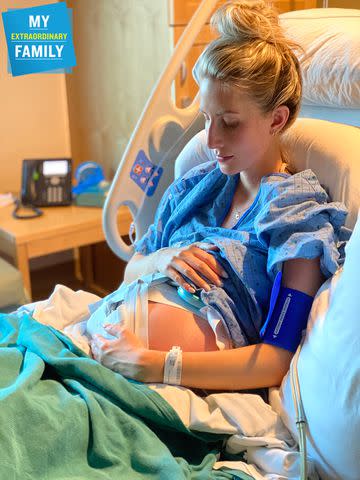
Courtesy Stewart Family
"We were so grateful our girls split early because all three embryos had their own sacs and placentas, so each baby gets its own nutrients," Shelby says. "But that added extra weight on me. They estimated I had 35 lbs. in my belly, and I had hyperemesis so I was on bed rest for a time with home IVs."
"A lot of people will joke with us and say they wish they could have triplets, but they don't understand how very high risk it is when you have multiples. Every number you go up, it gets scarier because they're guaranteed to be born premature and every time you go to the doctor, you're just hoping to make it to the next milestone," the father of four notes.
"Every time we went to the doctor and had to ask, ‘If we had to deliver next week would they survive?’ You have to go through that every time, you're just constantly stressed about it."
After four weeks of "inactive free-term labor" Shelby and Chase welcomed their triplets — daughters Etta and Margot and son Garner — at 35 weeks. But the surprises weren't done for the couple, who noticed that their two girls didn't look identical.
"Our whole pregnancy, we were told that because we had two girls and a boy that our girl embryo split early and we never second-guessed it. We were just really looking forward to finding out what the third baby was," Shelby says.
"When we found out it was a girl, our girl split, that was awesome. I remember my birth — it was pretty traumatic so I don’t remember a lot of the C-section — one of my vivid memories is Margot, they were holding her up, and they were saying, ‘Look she has so much hair.’ And I remember being like, 'Oh my gosh, so much hair.' A couple of days go by and every time we go to the NICU, we're like ‘They don't even really resemble each other.’ "
Shelby continues, "Even our NICU nurses were like, ‘Are your girls identical?' And I was like, 'They're supposed to be,' as a joke. There are some reasons why identical twins don’t look identical, which I knew because I researched all of that when I was pregnant because I was so worried about how I'd be able to tell them apart. And then they don’t look alike."
Shelby's thoughts took a backseat after she was rushed back to the hospital and diagnosed with peripartum cardiomyopathy five days after she was first discharged.
"It wasn't something they were really expecting to happen, so my recovery was a lot slower [than we thought]. We get home with the babies and every single time someone came to meet them, they would say, ‘I thought your girls were identical.’"
The more visitors they got, the more they heard that Etta and Margot did not look alike.
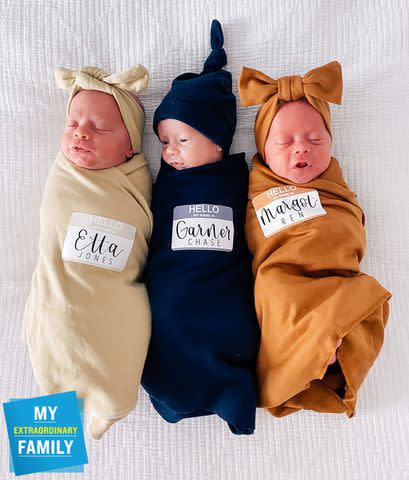
Courtesy Stewart Family
"They’d say, ‘Well they put a third embryo in.’ And that’s one thing I will say, people who haven’t gone through IVF or infertility throw things out like that, not understanding the repercussions. You don't understand how that works, and also you don't understand what that means if that's actually true. What you're just saying to me in jest is not a joke," she says.
Chase agrees, noting, "We could have that baby taken away from us."
Noting how difficult the incessant commentary was for her "while I was postpartum with triplets and hemorrhaged bad during my c-section and have decreased heart function," Shelby says she and Chase made the decision to independently DNA test their triplets.
"A lot of people think when we talk about the DNA testing, that we were trying to catch our fertility clinic in something, which was not the case. We wanted to know more for the girls themselves so that they had their identity and knew what happened and how they came to be," Chase shares. "We think that’s important."
"I should know why I have three babies inside me because we literally put these babies inside me," Shelby says. "So when we DNA tested them, part of me was hoping they would come back as identical and all those weird little things that people told me would go away. It came back fraternal and honestly, I didn't know what to do. I was like, 'What did actually happen?'"
While it eased the couple's concerns that they had possibly ended up with someone else's embryo, it didn't provide a clear scope of what happened. At that point, Shelby reached out to a genetic counselor that she'd previously connected with regarding some of her early concerns about health complications that come with triplet pregnancies.
"I told her what was going on. She's like, 'Let's just go through all of the super obvious things' and she was amazing with me," she shares, explaining that the counselor also offered to consult colleagues to help the confused couple get their answers.
"She got back to me and was like, ‘None of us have had this happen before. Here's what we've come up with.’ We went through the list together and basically disregarded most of them right off the bat. All our babies are healthy. All our babies have the correct genitalia. We came to the fact that either I did get naturally pregnant or there was the presence of a third embryo."
The latter was quickly dismissed by Chase's filming of their embryo transfer, which is legally allowed in their state. A rewatch confirmed only two embryos were present, leading the couple to finally loop their fertility clinic in on the concerns.
The couple and their clinic each independently verified they had the correct number of embryos remaining in storage, which led them to ask when the couple was last intimate before the procedure.
"While we were doing the shots and everything to prepare for a transfer, I had a small follicle, which was weird because I don't grow my own follicles. I don't ovulate on my own. We did an ultrasound for it and they were 'You're doing a medicated frozen embryo cycle, so that prevents you from ovulating. You're fine.'"
Shelby even double-checked before planning an anniversary getaway for 10 days before the transfer and was given the green light. Chase had brought up the follicle as a possibility when they first learned they were having triplets, only to be told it was nearly impossible.
"So I told her the exact date we went away and she said, 'On this day you had a follicle that we never checked again after that. Sperm can last inside the body up to six days.'"
Shelby continues, "The sperm would have been in my body for five days. It would have had to drop and then fertilize and then implant on the same day. And we knew all three of them implanted at the same time because they measured exactly the same."
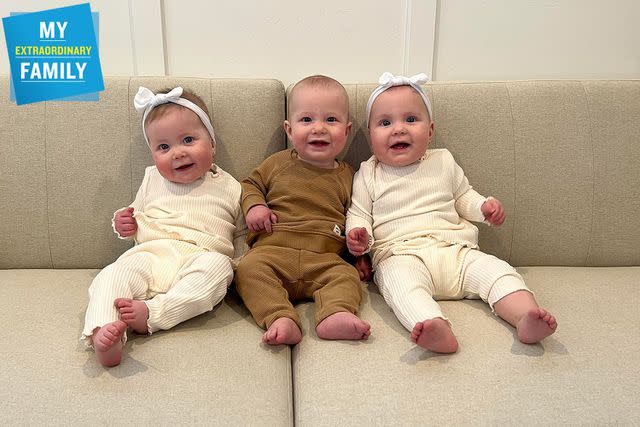
Courtesy Stewart Family
To shore up the theory, the genetic testing facility that tested the embryos before the couple transferred two was asked to see if there was any more genetic samples from the couple's embryos to pull a DNA profile for the girl embryo that was transferred.
"That specimen is only a couple of cells," she explains, noting the couple had to pay out of pocket to test them with a 20 percent chance of success.
"She comes back a week later and says, 'You're not going to believe this. We were able to pull the profile. It matches your baby B, Etta.' And it was a super cool moment for us because we thought Etta was our embryo and Margot was the spontaneous baby. That was her womb personality and that is her life personality."
Chase adds, "It's our personal belief, but we always say that we had three miscarriages and the reason that happened was because they weren't meant to come by themselves. They were meant to come together."
That bond continues to this day, as the triplets — now toddlers — enjoy every moment they're together.
"They sleep in the same room and they kiss each other good night. They do fight, they're 2, but they're a little gang," she says. "They couldn't have come earlier. It couldn't have been Etta, then Garner, then Margot. They had to come at the same time because they had to be together, which is really comforting to me in the moments that having four kids is hard."
The couple is thankful to have some help from big sister Bennett.
"We didn't realize how lucky we were to have Bennett's personality as our oldest until the triplets. She went through infertility with us. She saw me miscarry during our third miscarriage. And once the triplets came home, she called them her babies. She's never really jealous and always wants to be involved. And she worked hard for them too."
The Stewarts hope that by sharing their family's story, they can bring more awareness to IVF and how that process impacts both men and women.
"I think from my perspective, I've had friends that are going through infertility reach out to me because they know how open Shelby’s been about things. They'll ask me for advice or recommendations because Shelby's really become one that is trusted in a lot of our communities to talk to," Chase says.
"I want us to support each other because people don't talk about it. And that's how I started sharing, I want to be the person who's talking about this," Shelby adds, noting she also found a community that has continued to support her as she navigates being a mom of multiples.
"I found those people on Instagram, this whole triplet community and it was so amazing to me. I want to be that for other people. Moms reach out that are pregnant with triplets and feel scared and alone and I am so grateful to be able to pay it forward, to be that person for somebody else."
And while they navigate the ups and downs of four children, they do so with immense gratitude for the journey that brought them here.
"I think the hard thing is you have to commit to being very regimented and scheduled with multiples because you can't afford to miss a nap with one and then none of them sleep. You have to be very strict. But they're such awesome kids. We work hard to intentionally make each of them feel important and not always refer to them as the triplets, as a single unit," Chase says.
"As a mom, I always worry I'm not doing enough for them, but they have this bond that lets me know they're going to be okay," Shelby says. "They're going to be better for this and yes, it sucks right now when you're changing 147 diapers a week, but it's worth it to see these sibling bonds, to know they'll never be alone."
For more People news, make sure to sign up for our newsletter!
Read the original article on People.


